
The Burns' Day Storm was an extremely violent windstorm that took place on 25–26 January 1990 over North-Western Europe. It is one of the strongest European windstorms on record and caused many fatalities in the UK and Europe. This storm has received different names, as there was no official list of such events in Europe at the time. Starting on Burns Day, the birthday of the Scottish poet Robert Burns, it caused widespread damage and hurricane-force winds over a wide area.

Cyclone Kyrill was a low-pressure area that evolved into an unusually violent European windstorm, forming an extratropical cyclone with hurricane-strength winds. It formed over Newfoundland on 15 January 2007 and moved across the Atlantic Ocean reaching Ireland and Great Britain by the evening of 17 January. The storm then crossed the North Sea on 17 and 18 January, making landfall on the German and Dutch coasts on the afternoon of 18 January, before moving eastwards toward Poland and the Baltic Sea on the night from 18 to 19 January and further on to northern Russia.

Cyclone Tilo was a European windstorm which affected northern and western Europe in early November 2007. Combining with the remnants of Hurricane Noel, Tilo's storm surge led to the North Sea flood of 2007, affecting the coastlines of the Netherlands, the United Kingdom, Germany, Denmark, Norway and Belgium, starting on the night of 8–9 November 2007.
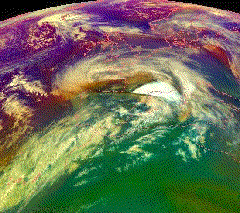
European windstorms are powerful extratropical cyclones which form as cyclonic windstorms associated with areas of low atmospheric pressure. They can occur throughout the year, but are most frequent between October and March, with peak intensity in the winter months. Deep areas of low pressure are common over the North Atlantic, and occasionally start as nor'easters off the New England coast. They frequently track across the North Atlantic Ocean towards the north of Scotland and into the Norwegian Sea, which generally minimizes the impact to inland areas; however, if the track is further south, it may cause adverse weather conditions across Central Europe, Northern Europe and especially Western Europe. The countries most commonly affected include the United Kingdom, Ireland, the Netherlands, Norway, Germany, the Faroe Islands and Iceland.
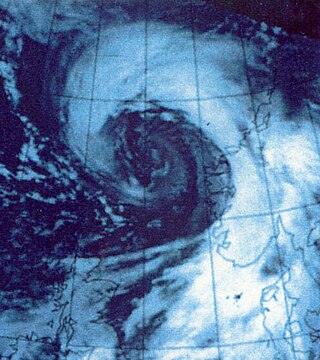
The New Year's Day Storm, known in Scotland as the 'Hogmanay Hurricane', was an intense European windstorm that affected much of northern Scotland and western Norway on 1 January 1992. DNMI estimated the strongest sustained winds and the strongest gusts to have reached 103 mph and 138 mph, respectively. Unofficial records of gusts in excess of 170 knots (87 m/s) were recorded in Shetland, while Statfjord-B in the North Sea recorded wind gusts in excess of 145 knots (75 m/s). There were very few fatalities, mainly due to the rather low population of the islands, the fact that the islanders are used to powerful winds, and because it struck in the morning on a public holiday when people were indoors. In Norway there was one fatality, in Frei, Møre og Romsdal county. There were also two fatalities on Unst in the Shetland Isles. Despite being referred to by some as a 'Hurricane', the storm was Extratropical in origin and is classified as an Extratropical Cyclone.
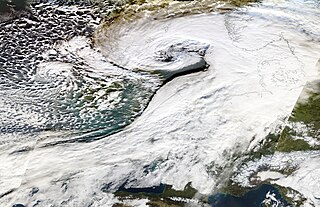
Cyclone Ulli was an intense European windstorm. Forming on December 31, 2011 off the coast of New Jersey, Ulli began a rapid strengthening phase on January 2 as it sped across the Atlantic. Ulli was the costliest disaster in January 2012 globally. The damage from the storm in Glasgow was also compared to a storm in 1968.

Cyclone Andrea was an intense European windstorm that affected western and central Europe in early January 2012.

Cyclone Quimburga, also referred to as the Lower Saxony Storm, was a deadly European windstorm that struck northern and central Europe between 12 and 14 November, 1972. The storm has been described as one of the most devastating storm events during the 20th century.

Cyclone Oratia, was an unusually deep European windstorm which affected Western Europe from 28 to 30 October 2000. The storm was the fiercest to hit Britain in October since the Great Storm of 1987, with wind gusts reaching 109 mph (175 km/h), and gusting at up to 70 mph (110 km/h) over much of the south of England. Its barometric pressure fell to 941 hPa (27.8 inHg), over the North Sea making it one of the deepest lows recorded in the country in October. The lowest land-based pressure observation reached 951.2 hPa (28.09 inHg) at RAF Fylingdales. The storm contributed to the Autumn 2000 western Europe floods.
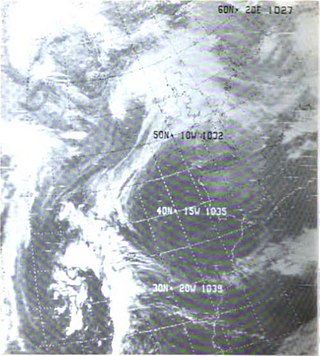
The Gale of January 1976, widely known as the "Capella" storm in Germany and the Ruisbroek flood in Belgium, was one in a series of extratropical cyclones and storm surges, which occurred over January 1976. The gale of 2–5 January 1976 resulted in severe wind damage across western and central Europe and coastal flooding around the southern North Sea coasts. At the time, this was the most severe storm of the century over the British Isles. Total fatalities reached 82 across Europe, although a figure of 100 is given by the World Meteorological Organization. Of these 24 were reported in Britain and 4 in Ireland. Overall losses of US$1.3 billion were incurred, with insured losses standing at US$500 million (1976).

Storm Jeanett was a strong extratropical cyclone and European windstorm which affected much of northwest Europe on 27–28 October 2002. The storm brought strong winds and heavy rainfall, with wind speeds reaching up to 180 km/h uprooting trees, smashing cars and damaging buildings. The storm was responsible for a total of 33 deaths across Europe, including Britain, the Netherlands, France, Austria, Belgium, Denmark, Poland, Switzerland and Sweden. The majority of the fatalities were caused by falling trees.

The St. Jude storm, also known as Cyclone Christian, and other names, was a severe hurricane-force European windstorm that hit Northwestern Europe on 27 and 28 October 2013 causing at least 17 deaths. The highest windspeed was in Denmark, where a gust of 194.4 km/h (120.8 mph) was recorded in the south of the country on the afternoon of 28 October, the strongest wind recorded in the country's history.

Weather system naming in Europe follows several multinational schemes under the EUMETNET framework. On the north Atlantic coast, the United Kingdom's Met Office, in collaboration with its Irish counterpart Met Éireann and, since 2019, its Dutch counterpart the Royal Netherlands Meteorological Institute (KNMI), decided to introduce a storm naming system following the St Jude's day storm on 27–28 October 2013 which caused 17 deaths in Europe and the 2013–14 Atlantic winter storms in Europe to give a single, authoritative naming system to prevent confusion with the media and public using different names for the same storms. The first European windstorm to be named was Abigail on 10 November 2015. The definitive list is combined from suggestions from the three countries.

Storm Darwin a European windstorm that Western Europe, particularly Ireland and the United Kingdom on 12 February 2014. The storm brought hurricane-force winds to Ireland the with the Met Office and Met Éireann describing the storm as one of the most significant to affect Ireland, Wales and West England in recent decades. Tini was one of the strongest storms of the 2013–2014 Atlantic winter storms in Europe, and also brought heavy across the UK and Ireland exacerbating the 2013–2014 United Kingdom winter floods, and may have been the most damaging storm of the period.
The 2017–2018 European windstorm season was the third instance of seasonal European windstorm naming. France, Spain and Portugal took part in winter storm naming for the first time this season.

Cyclone Egon was a European windstorm that affected the north of France, Belgium and Germany during the night of Thursday 12 to Friday 13 January 2017. It caused three deaths, widespread power outages, and wind damage and significant snowfall, primarily France and Germany, but also in the Benelux states, Austria and Switzerland.
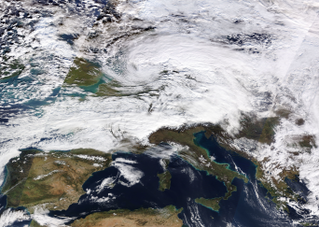
Storm David was a compact but deadly European windstorm that heavily affected the British Isles, France, Benelux, Central Europe, Northern Italy, Poland and parts of Eastern Europe in early 2018 with widespread hurricane-force gusts and severe snowfall, creating blizzard conditions in some areas. The storm caused extensive damage and traffic disruption. It was given the name David by Météo France while the FUB named it Friederike.
The 2018–2019 European windstorm season was the fourth instance of seasonal European windstorm naming in Europe. Most storms form between September and March. The first named storm, Ali, affected primarily the United Kingdom and Ireland on 19 September 2018.

Storm Ciara was a powerful and long-lived extratropical cyclone that was the first of a pair of European windstorms to affect the United Kingdom and Ireland at peak intensity less than a week apart in early February 2020, followed by Storm Dennis a week later. Ciara caused widespread wind and flooding damage across Europe, and at least 13 fatalities.

Storm Eunice was an extremely powerful extratropical cyclone with hurricane-force winds that was part of the 2021–2022 European windstorm season. Storm Eunice was named by the UK Met Office on 14 February 2022. A red weather warning was issued on 17 February for parts of South West England and South Wales, with a second red warning issued on 18 February, the day the storm struck, for London, the South East and East of England.






















